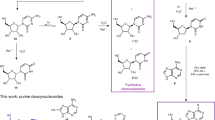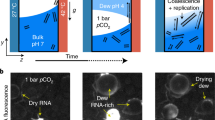Summary
Artesian groundwaters of high radionuclide concentration are ubiquitous and may have provided the large, sustained energy sources that were required to drive the multistage process of DNA and primordial cell evolution. The rapid, early development of the genetic code as well as its degeneracy can be attributed to exceptionally high radiation-induced mutation rates in this unique environment. The ability of double-strand DNA to direct enzymatic repair of radiation damage to single strands contributed importantly to its selective evolution. It is postulated that the polymerization of nucleotides took place at elevated temperatures within α-particle tracks of high ion and free-radical density, followed by rapid quenching to ambient conditions. It also is evident that radiation resistance and ploidy were important selection factors in cellular evolution.
Similar content being viewed by others
References
Agarwal KL, Büchi H, Caruthers MH, Gupta N, Khorana HG, Kleppe K, Kumar A, Ohtsuka E, Rajbhandary UL, van de Sande JH, Sgaramella V, Weber H, Yamada T (1970) Total synthesis of the gene for an alanine transfer ribonucleic acid from yeast. Nature 227:27–34
Asikainen M, Kahlos H (1979) Anomalously high concentrations of uranium, radium and radon in water from drilled wells in the Helsinki region. Geochim Cosmochim Acta 43:1681–1686
Avetisov VA, Goldanskii VI, Kuzmin VV (1991) Handedness, origin of life and evolution. Physics Today, July 1991, 33–41
Bauchinger M (1983) Microdosimetric aspects of the induction of chromosome aberrations. In: Ishihara T, Sasaki MS (eds) Radiation-induced chromosome damage in man. Alan Liss, New York, pp 1–22
Blanchard DC (1989) The ejection of drops from the sea and their enrichment with bacteria and other materials: A review. Estuaries 12:127–137
Bonner WA (1988) Origins of chiral homogeneity in nature. Stereochemistry 18:1–96
Calvin M (1969) Chemical evolution. Oxford University Press, New York, Oxford
Cavalier-Smith T (1989) Archaebacteria and Archezoa. Nature 339:100–101
Charlesby A (1987) Radiation chemistry of polymers. In: Farhataziz, Rodgers MAJ (eds) Radiation chemistry: principles and applications. VCH Publishers, pp 451–475
Chatterjee A, Maccabee HD, Tobias CA (1973) Radial cutoff LET and radial cutoff dose calculations for heavy charged particles in water. Radiat Res 54:479–494
Condon EU (1937) Theories of optical rotatory power. Revs Mod Phys 9:432–457
Contreras G, Espejo R, Mery E, Ohlbaum A, Tohá J (1962) Polymerization of ribomononucleotides by γ-radiation. Biochim Biophys Acta 61:718–727
Dickerson RE (1978) Chemical evolution and the origin of life. Sci Amer 239 No. 3:70–78
Dixon M, Webb EC (1979) Enzymes. Academic Press, New York
Elsasser WM (1981) Principles of a new biological theory: A summary. J Theoret Biol 89:131–150
Evans HJ (1977) Molecular mechanisms in the induction of chromosome aberrations. In: Progress in Genetic Toxicology, Elsevier/North Holland, pp 57–74
Fessenden RW (1977) Chemically induced electron polarization of radiolytically produced radicals. In: Minis LT, Atkins PW, McLauchlan KA, Pedersen JB (eds) Chemically induced magnetic polarization. D Reidel, Dordrecht-Holland, Boston, pp 119–150
Fox SW, Dose K (1977) Molecular evolution and the origin of life. Revised edition. Marcel Dekker, New York, Basel
Freeman GR (1987) Introduction. In: Freeman GR (ed) Kinetics of nonohomogeneous processes. John Wiley, New York pp 1–18
Goldberg AL, Wittes RE (1966) Genetic code: aspects of organization. Science 153:420–424
Haïssinsky M (1964) Nuclear chemistry and its applications. Addison-Wesley, Reading, MA
Haldane JBS (1945) A physicist looks at genetics. Nature 155: 375–376
Hütterman J, Köhnlein W, Téoule R (eds) (1978) Effects of ionizing radiation on DNA. Springer-Verlag, Berlin, Heidelberg, New York
Joyce GF, Visser GM, van Boeckel CAA, van Boom JH, Orgel LE, van Westrenen J (1984) Chiral selection in poly(C)-directed synthesis of oligo(G). Nature 310:602–604
Kabnick KS, Peatie DA (1991) Giardia: A missing link between prokaryotes and eukaryotes. Amer Scientist 79:34–43
Knoll AH, Barghoorn ES (1977) Archean microfossils showing cell division from the Swaziland System of South Africa. Science 198:396–398
Kotval JP, Gray LH (1947) Structural changes produced in microspores of Tradescantia by α-radiation. J Genet 48:135–154
Kuroda PK, Yokoyama Y (1953) Determination of thoron in mineral waters. Anal Chem 25:832–835
Kuroda PK (1956) On the nuclear physical stability of the uranium minerals. J Chem Phys 25:781–782
Labouygues JM, Figureau A (1984) The logic of the genetic code: synonyms and optimality against effects of mutations. Origin Life 14:685–693
Lea DC, Catchside DG (1945) The relation between recessive lethals, dominant lethals, and chromosome aberrations in Drosophila. J Genet 47:10–24
Lederer CM, Shirley VS (1978) Table of isotopes, seventh edition, John Wiley and Sons, New York
Lemmon RM (1970) Chemical evolution. Chem Rev 70:95–109
Lind SC (1961) Radiation chemistry of gases. Amer Chem Soc Monograph No 151
Magee JL, Chatterjee A (1987) Track reactions of radiation chemistry. In: Freeman GR (ed) Kinetics of nonhomogeneous processes. John Wiley, New York, pp 171–214
Margulis L (1981) Symbiosis in cell evolution. WH Freeman, San Francisco
Milvy P, Cothern CR (1989) Naturally occurring radionuclides in drinking water: An exercise in risk benefit analysis. Environ Geochem Hlth 11:63–72
Mitchell JS (1968) Applications of radiation chemistry in radiobiology and radiotherapeutics. In: Stein G (ed) Radiation chemistry of aqueous systems. Weizmann Science Press, Jerusalem, Israel, pp 287–303
Moore FD, Sastry KSR (1982) Intracellular potassium: 40K as a primordial gene irradiator. Proc Natl Acad Sci USA 79:3556–3559
Mozumder A, Magee JL (1966) Model of tracks of ionizing radiations for radical reaction mechanisms. Radiat Res 28:203–214
Ohno S (1971) Genetic implication of karyological instability of malignant somatic cells. Physiolog Revs 51:496–526
Orgel LE (1968) Evolution of the genetic apparatus. J Mol Biol 38:381–393
Pattee HH (1969) Physical problems of heredity and evolution. In: Waddington CH (ed) Towards a theoretical biology. Aldine, Chicago, pp 268–284
Patterson LK (1987) Instrumentation for measurement of transient behavior in radiation chemistry. In: Farhataziz, Rodgers MAJ (eds) Radiation chemistry: principles and applications. VCH Publishers, New York, pp 65–96
Ponnamperuma C (1967) The role of radiation in primordial organic synthesis. In: Silini G (ed) Radiation research 1966. North-Holland, Amsterdam, pp 700–713
Rich A (1965) Evolutionary problems in the synthesis of proteins. In: Bryson V, Vogel HJ (eds) Evolving genes and proteins. Academic Press, New York, pp 453–468
Ritter MA, Cleaver JE, Tobias CA (1977) High-LET radiations induce a large proportion of non-rejoining DNA breaks. Nature 266:653–655
Schidlowski M (1988) A 3,800-million-year isotopic record of life from carbon in sedimentary rocks. Nature 333:313–318
Scholes G (1983) Radiation effects on DNA. Brit J Radiol 56: 221–231
Schuessler H, Hartmann H (1985) Chromatographic studies on the radiolysis of DNA in aqueous solution. Int J Radiat Biol 47:509–521
Sonneborn TM (1965) Degeneracy of the genetic code: extent, nature, and genetic implications. In: Bryson V, Vogel HJ (eds) Evolving genes and proteins. Academic Press, New York, pp 377–397
Walton JC (1977) Organization and the origin of life. Origins 4:16–35
Watson JD, Crick FHC (1953) Molecular structure of nucleic acids. Nature 171:737–738
Yarus M (1988) A specific amino acid binding site composed of RNA. Science 240:1751–1758
Young B, Cech TR (1989) Specificity for 3′-5′-linked substrates in RNA-catalyzed RNA polymerization. J Mol Evol 29:480–485
Author information
Authors and Affiliations
Rights and permissions
About this article
Cite this article
Martell, E.A. Radionuclide-induced evolution of DNA and the origin of life. J Mol Evol 35, 346–355 (1992). https://doi.org/10.1007/BF00161172
Received:
Revised:
Accepted:
Issue Date:
DOI: https://doi.org/10.1007/BF00161172




